[English] 日本語
 Yorodumi
Yorodumi- PDB-6t59: Structure of rabbit 80S ribosome translating beta-tubulin in comp... -
+ Open data
Open data
- Basic information
Basic information
| Entry | Database: PDB / ID: 6t59 | ||||||||||||
|---|---|---|---|---|---|---|---|---|---|---|---|---|---|
| Title | Structure of rabbit 80S ribosome translating beta-tubulin in complex with tetratricopeptide protein 5 and nascent chain-associated complex | ||||||||||||
 Components Components |
| ||||||||||||
 Keywords Keywords | RIBOSOME / TUBULIN / nascent chain-associated complex / ribosome-nascent chain / tetratricopeptide protein 5 / autoregulation | ||||||||||||
| Function / homology |  Function and homology information Function and homology informationpositive regulation of mRNA catabolic process / ribosomal subunit / ubiquitin ligase inhibitor activity / positive regulation of signal transduction by p53 class mediator / protein-RNA complex assembly / rough endoplasmic reticulum / MDM2/MDM4 family protein binding / cytosolic ribosome / cellular response to starvation / ribosomal large subunit biogenesis ...positive regulation of mRNA catabolic process / ribosomal subunit / ubiquitin ligase inhibitor activity / positive regulation of signal transduction by p53 class mediator / protein-RNA complex assembly / rough endoplasmic reticulum / MDM2/MDM4 family protein binding / cytosolic ribosome / cellular response to starvation / ribosomal large subunit biogenesis / maturation of LSU-rRNA from tricistronic rRNA transcript (SSU-rRNA, 5.8S rRNA, LSU-rRNA) / Regulation of TP53 Activity through Methylation / antimicrobial humoral immune response mediated by antimicrobial peptide / large ribosomal subunit / regulation of translation / ribosome binding / 5S rRNA binding / ribosomal large subunit assembly / cytoplasmic vesicle / large ribosomal subunit rRNA binding / defense response to Gram-negative bacterium / killing of cells of another organism / cytosolic large ribosomal subunit / cytoplasmic translation / tRNA binding / postsynaptic density / rRNA binding / structural constituent of ribosome / ribosome / translation / mitochondrial matrix / ribonucleoprotein complex / DNA repair / mRNA binding / synapse / DNA damage response / chromatin binding / nucleolus / endoplasmic reticulum / positive regulation of transcription by RNA polymerase II / mitochondrion / DNA binding / RNA binding / zinc ion binding / nucleoplasm / nucleus / cytoplasm / cytosol Similarity search - Function | ||||||||||||
| Biological species |  Homo sapiens (human) Homo sapiens (human) | ||||||||||||
| Method | ELECTRON MICROSCOPY / single particle reconstruction / cryo EM / Resolution: 3.11 Å | ||||||||||||
 Authors Authors | Lin, Z. / Gasic, I. / Chandrasekaran, V. / Peters, N. / Shao, S. / Ramakrishnan, V. / Mitchison, T.J. / Hegde, R.S. | ||||||||||||
| Funding support |  United Kingdom, 3items United Kingdom, 3items
| ||||||||||||
 Citation Citation |  Journal: Science / Year: 2020 Journal: Science / Year: 2020Title: TTC5 mediates autoregulation of tubulin via mRNA degradation. Authors: Zhewang Lin / Ivana Gasic / Viswanathan Chandrasekaran / Niklas Peters / Sichen Shao / Timothy J Mitchison / Ramanujan S Hegde /   Abstract: Tubulins play crucial roles in cell division, intracellular traffic, and cell shape. Tubulin concentration is autoregulated by feedback control of messenger RNA (mRNA) degradation via an unknown ...Tubulins play crucial roles in cell division, intracellular traffic, and cell shape. Tubulin concentration is autoregulated by feedback control of messenger RNA (mRNA) degradation via an unknown mechanism. We identified tetratricopeptide protein 5 (TTC5) as a tubulin-specific ribosome-associating factor that triggers cotranslational degradation of tubulin mRNAs in response to excess soluble tubulin. Structural analysis revealed that TTC5 binds near the ribosome exit tunnel and engages the amino terminus of nascent tubulins. TTC5 mutants incapable of ribosome or nascent tubulin interaction abolished tubulin autoregulation and showed chromosome segregation defects during mitosis. Our findings show how a subset of mRNAs can be targeted for coordinated degradation by a specificity factor that recognizes the nascent polypeptides they encode. | ||||||||||||
| History |
|
- Structure visualization
Structure visualization
| Movie |
 Movie viewer Movie viewer |
|---|---|
| Structure viewer | Molecule:  Molmil Molmil Jmol/JSmol Jmol/JSmol |
- Downloads & links
Downloads & links
- Download
Download
| PDBx/mmCIF format |  6t59.cif.gz 6t59.cif.gz | 3.1 MB | Display |  PDBx/mmCIF format PDBx/mmCIF format |
|---|---|---|---|---|
| PDB format |  pdb6t59.ent.gz pdb6t59.ent.gz | Display |  PDB format PDB format | |
| PDBx/mmJSON format |  6t59.json.gz 6t59.json.gz | Tree view |  PDBx/mmJSON format PDBx/mmJSON format | |
| Others |  Other downloads Other downloads |
-Validation report
| Summary document |  6t59_validation.pdf.gz 6t59_validation.pdf.gz | 1.8 MB | Display |  wwPDB validaton report wwPDB validaton report |
|---|---|---|---|---|
| Full document |  6t59_full_validation.pdf.gz 6t59_full_validation.pdf.gz | 1.8 MB | Display | |
| Data in XML |  6t59_validation.xml.gz 6t59_validation.xml.gz | 239.6 KB | Display | |
| Data in CIF |  6t59_validation.cif.gz 6t59_validation.cif.gz | 412.1 KB | Display | |
| Arichive directory |  https://data.pdbj.org/pub/pdb/validation_reports/t5/6t59 https://data.pdbj.org/pub/pdb/validation_reports/t5/6t59 ftp://data.pdbj.org/pub/pdb/validation_reports/t5/6t59 ftp://data.pdbj.org/pub/pdb/validation_reports/t5/6t59 | HTTPS FTP |
-Related structure data
| Related structure data |  10380MC M: map data used to model this data C: citing same article ( |
|---|---|
| Similar structure data |
- Links
Links
- Assembly
Assembly
| Deposited unit | 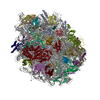
|
|---|---|
| 1 |
|
- Components
Components
-Ribosomal protein ... , 8 types, 8 molecules A3J3M3N3V3Y3j3t3
| #1: Protein | Mass: 28088.863 Da / Num. of mol.: 1 / Source method: isolated from a natural source / Source: (natural)  |
|---|---|
| #10: Protein | Mass: 20288.465 Da / Num. of mol.: 1 / Source method: isolated from a natural source / Source: (natural)  |
| #12: Protein | Mass: 23870.549 Da / Num. of mol.: 1 / Source method: isolated from a natural source / Source: (natural)  |
| #13: Protein | Mass: 24207.285 Da / Num. of mol.: 1 / Source method: isolated from a natural source / Source: (natural)  |
| #21: Protein | Mass: 14892.505 Da / Num. of mol.: 1 / Source method: isolated from a natural source / Source: (natural)  |
| #24: Protein | Mass: 17303.363 Da / Num. of mol.: 1 / Source method: isolated from a natural source / Source: (natural)  |
| #35: Protein | Mass: 11111.032 Da / Num. of mol.: 1 / Source method: isolated from a natural source / Source: (natural)  |
| #44: Protein | Mass: 17847.619 Da / Num. of mol.: 1 / Source method: isolated from a natural source / Source: (natural)  |
+Protein , 33 types, 33 molecules B3C3F3G3H3L3O3P3Q3R3S3T3U3W3X3a3b3c3d3e3f3g3h3k3l3m3o3p3r3s3...
-60S ribosomal protein ... , 6 types, 6 molecules D3E3I3Z3i3n3
| #4: Protein | Mass: 34481.828 Da / Num. of mol.: 1 / Source method: isolated from a natural source / Source: (natural)  |
|---|---|
| #5: Protein | Mass: 33028.336 Da / Num. of mol.: 1 / Source method: isolated from a natural source / Source: (natural)  |
| #9: Protein | Mass: 24643.057 Da / Num. of mol.: 1 / Source method: isolated from a natural source / Source: (natural)  |
| #25: Protein | Mass: 15835.831 Da / Num. of mol.: 1 / Source method: isolated from a natural source / Source: (natural)  |
| #34: Protein | Mass: 12263.834 Da / Num. of mol.: 1 / Source method: isolated from a natural source / Source: (natural)  |
| #39: Protein/peptide | Mass: 3473.451 Da / Num. of mol.: 1 / Source method: isolated from a natural source / Source: (natural)  |
-RNA chain , 4 types, 4 molecules 23547484
| #45: RNA chain | Mass: 24436.551 Da / Num. of mol.: 1 / Source method: isolated from a natural source / Source: (natural)  |
|---|---|
| #46: RNA chain | Mass: 1148115.375 Da / Num. of mol.: 1 / Source method: isolated from a natural source / Source: (natural)  |
| #47: RNA chain | Mass: 38691.914 Da / Num. of mol.: 1 / Source method: isolated from a natural source / Source: (natural)  |
| #48: RNA chain | Mass: 50143.648 Da / Num. of mol.: 1 / Source method: isolated from a natural source / Source: (natural)  |
-Nascent polypeptide-associated complex subunit ... , 2 types, 2 molecules NINA
| #49: Protein/peptide | Mass: 2147.389 Da / Num. of mol.: 1 / Source method: isolated from a natural source / Source: (natural)  |
|---|---|
| #50: Protein | Mass: 23406.824 Da / Num. of mol.: 1 / Source method: isolated from a natural source / Source: (natural)  |
-Non-polymers , 2 types, 225 molecules 


| #54: Chemical | ChemComp-MG / #55: Chemical | ChemComp-ZN / |
|---|
-Details
| Has ligand of interest | N |
|---|---|
| Has protein modification | Y |
-Experimental details
-Experiment
| Experiment | Method: ELECTRON MICROSCOPY |
|---|---|
| EM experiment | Aggregation state: PARTICLE / 3D reconstruction method: single particle reconstruction |
- Sample preparation
Sample preparation
| Component |
| ||||||||||||||||||||||||||||
|---|---|---|---|---|---|---|---|---|---|---|---|---|---|---|---|---|---|---|---|---|---|---|---|---|---|---|---|---|---|
| Molecular weight | Value: 4.5 MDa / Experimental value: NO | ||||||||||||||||||||||||||||
| Source (natural) |
| ||||||||||||||||||||||||||||
| Source (recombinant) | Organism:  | ||||||||||||||||||||||||||||
| Buffer solution | pH: 7.4 | ||||||||||||||||||||||||||||
| Specimen | Embedding applied: NO / Shadowing applied: NO / Staining applied: NO / Vitrification applied: YES | ||||||||||||||||||||||||||||
| Vitrification | Cryogen name: ETHANE |
- Electron microscopy imaging
Electron microscopy imaging
| Experimental equipment |  Model: Titan Krios / Image courtesy: FEI Company |
|---|---|
| Microscopy | Model: FEI TITAN KRIOS |
| Electron gun | Electron source:  FIELD EMISSION GUN / Accelerating voltage: 300 kV / Illumination mode: FLOOD BEAM FIELD EMISSION GUN / Accelerating voltage: 300 kV / Illumination mode: FLOOD BEAM |
| Electron lens | Mode: BRIGHT FIELD |
| Image recording | Electron dose: 48.36 e/Å2 / Detector mode: INTEGRATING / Film or detector model: FEI FALCON III (4k x 4k) |
- Processing
Processing
| EM software | Name: EPU / Category: image acquisition |
|---|---|
| CTF correction | Type: PHASE FLIPPING AND AMPLITUDE CORRECTION |
| Symmetry | Point symmetry: C1 (asymmetric) |
| 3D reconstruction | Resolution: 3.11 Å / Resolution method: FSC 0.143 CUT-OFF / Num. of particles: 49626 / Symmetry type: POINT |
 Movie
Movie Controller
Controller


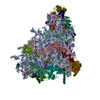
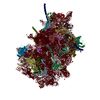


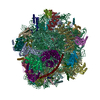
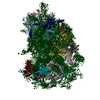
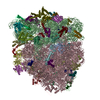
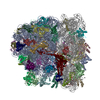

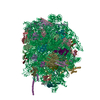
 PDBj
PDBj


































